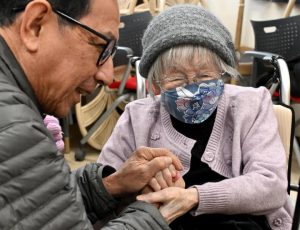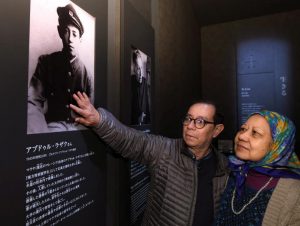On visit to Japan, oldest son of Southern Special Student from Malaysia has first meeting with woman who knew his father from A-bombing
Feb. 5, 2024
by Kyoko Niiyama, Staff Writer
The oldest son of the late Abdul Razak — a “Southern Special Student” from Malaysia who experienced the atomic bombing while studying at the Hiroshima University of Literature and Science (now Hiroshima University) — visited Hiroshima City to retrace the steps taken at that time by his father. Dzulkifli Bin Abdul Razak, 72, was able to meet for the first time with an A-bomb survivor who had taken refuge with his father after the bombing, an encounter that led him to ponder how the international students and citizens tried desperately to survive amidst the extreme chaos by offering each other encouragement.
At the end of January, Dzulkifli paid a visit to Yano Orizuru En, a special nursing home for A-bomb survivors, located in Hiroshima’s Aki Ward, and spoke through an interpreter to Meiko Kurihara, 97, a resident of the home. “I’m happy to meet with you. After the atomic bombing, did you suffer any illness?” During the conversation, Ms. Kurihara mentioned that Dzulkifli looked a lot like his father.
On that day, August 6, 1945, Ms. Kurihara experienced the atomic bombing at Toyo Kogyo (present-day Mazda Motor Corporation), where she was working as a mobilized student. Her home in the area of Ote-machi (in what is now Hiroshima’s Naka Ward) burned to the ground. For about one week, she walked around in search of her missing father while sheltering with the Southern Special Students in the schoolyard of Hiroshima University. Recalled Ms. Kurihara, “Mr. Razak was the kindest to me. We shared food and together slept out in the open.”
Mr. Razak, then 20, was in class when the atomic bombing happened. He survived by crawling out from under the collapsed wooden school building, located about 1.5 kilometers from the hypocenter. After the war, he devoted his life to the development of Japanese-language education in his country. He was awarded an honorary doctoral degree from Hiroshima University in 2013 and died that same year, at the age of 88.
“Every year on August 6, my father gathered family members together to share his experience in the bombing with us. I understand that he tried hard to save women students by pulling them onto a raft,” Dzulkifli said. On his visit, he also toured the Hiroshima Peace Memorial Museum. “As if seeing the actual images, I came to understand clearly the situation my father had described to us while he was alive.” In a section of the museum that introduces the overseas nationals who experienced the atomic bombing, Dzulkifli looked intently at the panel with a photograph of his father, taken in 1945 and provided to the museum by Mr. Razak himself, as well as at the exhibit’s explanatory panel.
Dzulkifli serves as president of the International Islamic University Malaysia, in Kuala Lumpur, Malaysia’s capital city. Wanting to learn more about what his father had experienced, he turned to a citizens group in Hiroshima working to uncover the history of the Southern Special Students. On his visit to the A-bombed city with his family, he was able to meet with Ms. Kurihara. They also went to the site of Konan-ryo (in Hiroshima’s present-day Naka Ward), the dormitory where Mr. Razak and other international students had lived.
There were seven other Southern Special Students affected by the atomic bombing besides Mr. Razak, and two of them died in the bombing. Those able to return to their home countries have also died. It is now up to Dzulkifli’s generation to carry on their memories of that time.
Ms. Kurihara said to Dzulkifli, “I’m opposed to war. It is important to live by helping each other, without resorting to the production of any nuclear weapons.” He replied, “I will definitely tell my children and students about the experiences you and my father shared in the atomic bombing and the importance of peace.” They grasped hands with the promise to meet again.
Keywords
Southern Special Students
During the Pacific theater of World War II, the Southern Special Students program, a system for overseas students from Southeast Asia, was established and funded by Japan’s national government as part of its Greater East Asia Co-Prosperity Sphere concept. About 200 people from Southeast Asian countries, including present-day Indonesia and Malaysia, were selected and invited to Japan to study at universities in different parts of the country during the period 1943–1944. At the time of the atomic bombing, nine students were enrolled at the Hiroshima University of Literature and Science. Two of those nine students, Syed Omar and Nik Yusof, died in the bombing.
(Originally published on February 5, 2024)
The oldest son of the late Abdul Razak — a “Southern Special Student” from Malaysia who experienced the atomic bombing while studying at the Hiroshima University of Literature and Science (now Hiroshima University) — visited Hiroshima City to retrace the steps taken at that time by his father. Dzulkifli Bin Abdul Razak, 72, was able to meet for the first time with an A-bomb survivor who had taken refuge with his father after the bombing, an encounter that led him to ponder how the international students and citizens tried desperately to survive amidst the extreme chaos by offering each other encouragement.
At the end of January, Dzulkifli paid a visit to Yano Orizuru En, a special nursing home for A-bomb survivors, located in Hiroshima’s Aki Ward, and spoke through an interpreter to Meiko Kurihara, 97, a resident of the home. “I’m happy to meet with you. After the atomic bombing, did you suffer any illness?” During the conversation, Ms. Kurihara mentioned that Dzulkifli looked a lot like his father.
On that day, August 6, 1945, Ms. Kurihara experienced the atomic bombing at Toyo Kogyo (present-day Mazda Motor Corporation), where she was working as a mobilized student. Her home in the area of Ote-machi (in what is now Hiroshima’s Naka Ward) burned to the ground. For about one week, she walked around in search of her missing father while sheltering with the Southern Special Students in the schoolyard of Hiroshima University. Recalled Ms. Kurihara, “Mr. Razak was the kindest to me. We shared food and together slept out in the open.”
Mr. Razak, then 20, was in class when the atomic bombing happened. He survived by crawling out from under the collapsed wooden school building, located about 1.5 kilometers from the hypocenter. After the war, he devoted his life to the development of Japanese-language education in his country. He was awarded an honorary doctoral degree from Hiroshima University in 2013 and died that same year, at the age of 88.
“Every year on August 6, my father gathered family members together to share his experience in the bombing with us. I understand that he tried hard to save women students by pulling them onto a raft,” Dzulkifli said. On his visit, he also toured the Hiroshima Peace Memorial Museum. “As if seeing the actual images, I came to understand clearly the situation my father had described to us while he was alive.” In a section of the museum that introduces the overseas nationals who experienced the atomic bombing, Dzulkifli looked intently at the panel with a photograph of his father, taken in 1945 and provided to the museum by Mr. Razak himself, as well as at the exhibit’s explanatory panel.
Dzulkifli serves as president of the International Islamic University Malaysia, in Kuala Lumpur, Malaysia’s capital city. Wanting to learn more about what his father had experienced, he turned to a citizens group in Hiroshima working to uncover the history of the Southern Special Students. On his visit to the A-bombed city with his family, he was able to meet with Ms. Kurihara. They also went to the site of Konan-ryo (in Hiroshima’s present-day Naka Ward), the dormitory where Mr. Razak and other international students had lived.
There were seven other Southern Special Students affected by the atomic bombing besides Mr. Razak, and two of them died in the bombing. Those able to return to their home countries have also died. It is now up to Dzulkifli’s generation to carry on their memories of that time.
Ms. Kurihara said to Dzulkifli, “I’m opposed to war. It is important to live by helping each other, without resorting to the production of any nuclear weapons.” He replied, “I will definitely tell my children and students about the experiences you and my father shared in the atomic bombing and the importance of peace.” They grasped hands with the promise to meet again.
Keywords
Southern Special Students
During the Pacific theater of World War II, the Southern Special Students program, a system for overseas students from Southeast Asia, was established and funded by Japan’s national government as part of its Greater East Asia Co-Prosperity Sphere concept. About 200 people from Southeast Asian countries, including present-day Indonesia and Malaysia, were selected and invited to Japan to study at universities in different parts of the country during the period 1943–1944. At the time of the atomic bombing, nine students were enrolled at the Hiroshima University of Literature and Science. Two of those nine students, Syed Omar and Nik Yusof, died in the bombing.
(Originally published on February 5, 2024)









